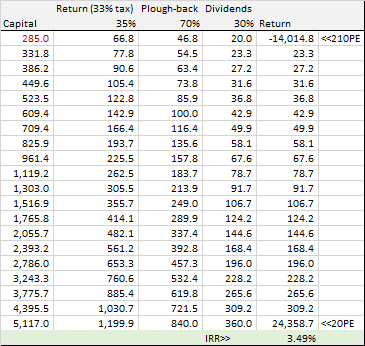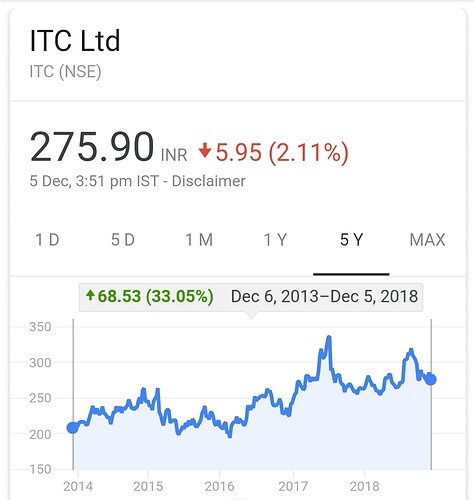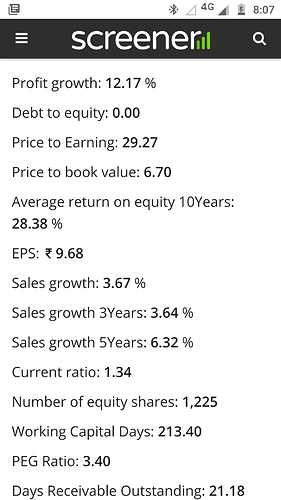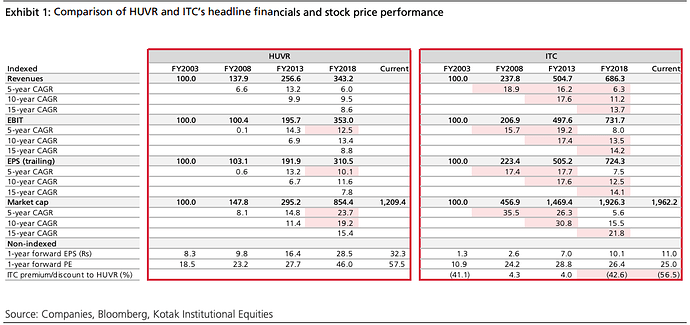Tata Global Beverages is also placed in a good position by virtue of its Brands Tata Tea, Eight O Clock, Tetley, Himalayan, Alliance with Starbucks and lastly it’s ownership in Tata Coffee
ITC is not strictly FMCG and neither is valued as FMCG. I completely understand what FMCG is but thanks for your efforts in explaining above. I was not comparing trying to do any analogy. I was discussing with someone on consumer facing stocks which are proxy consumption. Point taken they are not FMCG companies so let us not discuss them here.
ITC > 80% profits is from Cig and if I am not wrong Cig + Other FMCG revenue is also > 60% of TO.
Lets check test of FMCG
Is Cig : High Frequency / Repeat consumption : Yes
Is Cig : Low cost to overall benefit : Yes ( atleast to smokers )
Is Cig a individual / household purchase yes - No painter / plumber etc act as influencers / intermediary
With the safety of capital that it offers, 12 TO 15% in the long run is gold !
However, currently its sales growth is low therefore its share price is not going to run away anytime soon. I wouldn’t want to pay PE 30 for it. But, yes, it is a great buy for the long run.
FD kind of returns in the last 5 years. Somewhere ITC lost its mojo competing with HULs at one side and Patanjali on the other. Just my guess, management seems contented and might instead need a turnaround CEO like Sanjiv Mehta of HUL.
Nevertheless, a very safe stock considering 30x earnings.
Hi Sir,
You cannot base decisions off of a PE multiple. A PE is nothing but a function of earnings today and price today. Earnings will change in the future and so will the stock price. I personally believe that if we had ready access to a 3 year forward PE with extremely conservative estimates instead of PE today, many more investors would be open to buying quality companies.
Let us understand what drives a stock price. If you were to conduct an analysis of page industries stock price you notice that out of some 40% cagr (could be wrong with regards to exact figures) some 28-30% has come from earnings growth. Whereas only 10-12% has come from the re-rating inspite of an enormous jump in the PE multiple. you can conduct this in reverse as well.
Assuming you want 11% cagr. And a business does roce of 35%. Pays out 30% of earnings i.e reinvests 70% at a 35% roce. This occurs every year for 20 years starting with a base capital of 100. And assuming the stocks PE resorts to mean after 20 years. Mean PE is around 20 for majority of the high quality businesses if they dont have visibility. Using these assumptions to achieve a 11%cagr in 20 years guess how much we can pay on a PE basis today assuming a derating to 20. 210x. We can pay 210x today for such a business. Now imagine that you buy this business for 50x. You will end up making 20% cagr. Assuming you enter at 50x and the stock derates to 20 after 20 years. This tells you that PE does not matter. Think of the PE like a one off other income. Low PE means you make the meagre re-rating difference because earnings is covering most of the returns. If you want to bring in the PE argument for a company that is cyclical or does not have earnings growth then yes it matters. But for companies like ITC, Asian paints etc: PE doesnt matter. See a 10% increase in sales growth each year will lead to far bigger increase in bottom line, this could be due to efficiencies, operating and financial leverage etc: sometimes this number could go up to 25% cagr even. Case in point could be an Abbott India where sales went from 2300cr-3300cr between 14-18 but profits doubled in the same period from 200cr - 400cr. In 14 the stock traded at 25x which must have been expensive in that market I’m sure. If page was expensive at 15-20x then paying 25x was definately steep (I wasnt in the market back then, I started a year ago so please cross check) Today earnings have doubled and the stock trades at 35x approx. If you do the math you will find out that even had the PE derated to 20x from 25x the stock price on account earnings growth would be approximately 3700 vis a vis 1700 in 2014. So PE really is not something to base your investments on for quality compounding kinds of businesses with high return metrics.
I hope I have made sense here. These are some of my learnings through reading and studying the wonderful conncept of compounding wealth by investing in businesses  @jamit05
@jamit05
This is the sales growth for ITC…
It is meagre you would agree. If sales are not growing, then something is amiss, which I do not see getting fixed in the short term.
I believe, after demonization the ability of the people to spend, in general, has been decimated. Middle and lower class people scrimp on necessities; additional items are even more affected. ITC will feel the brunt all the more as it is not anchored.
Another couple of Negatives. It is spreading itself into different businesses, not specializing. Itc doesn’t appear to be anchored, except in Cigarettes, which is not growing enough to justify the size, this will cause RoE to reduce in the days to come.
In recent times, many a stock, with poor sales and falling numbers has tumbled. Therefore, in my mind, there is no possibility for paying any premium to ITC.
Coming right to the point. What is a price to pay, and what to expect?
Due to these Negatives, since 2013 the stock price has crawled, where other good quality stocks have at least doubled. This is likely to continue. The stock price is likely to underperform. May or may not correct sharply, or maybe just in line with the Index, but RS.200, 2016 low is almost a given.
I see RoE falling further and the PE getting de-rated anytime soon. Established FMCG stocks will consolidated because of visibility of earnings which is good to stable, whereas for ITC it’s poor. Therefore, ITC may see a fall.
One can chart the future earnings of a very handful of companies, 5…10…20 years ahead. But for ITC there are uncertainties regarding growth, which is going to be stinted in the near term.
I am a huge fan of Large caps. I see so many members here confidently investing in mid and small caps. Some are doing well even, but I know that a sensible methodology of Investing in Large caps can beat an assorted bag of stocks, while ensuring full safety of capital.
I am working on one such approach, about which I will start a thread, once I have the approval of the Seniors.
Can you show me how you got 11% CAGR on a stock which gives post-tax return of 35 on 100 of capital for 20 years straight. I don’t get more than 8%. Your assumptions are herculean. 35% post-tax return for 20 years straight with payout of 30% from day one is just fantasy. It has to be a straight-up monopoly with substantial government clout/backing.
I am no market guru, but ignoring purchase PE has burnt lots of small investors.

It will good to know your portfolio else all these are theoretical discussions without any substance. If not ITC what are you invested in? If you are not substantially in equity it hardly matters
Is the repeat consumption of cig due to addiction: Yes
Is the perceived overall benefit a true benefit: No
Can cig economy be influenced by government, doctors, individuals, family members: Yes
With due respect ITC have been and is a great business. I liked their vision to move to FMCG, something on the lines of the top tobacco company in the world which later on demerged its FMCG part. But unfortunately, we cannot call cigarette a pure FMCG business as it has controls and parameters much more than a FMCG product and hence it is valued likevise. I would be happy if market values it as pure FMCG as I am invested in it (though not a significant part of my portfolio).
Still does not work. Actually on a after-tax basis, you will end up with 3% IRR if you buy at 210PE. Cut the return down to a sustainable 15%, at 210 purchase PE, you will have negative IRR.

You said 35% pre-tax so I applied 33% tax. Now you are saying post-tax. I am not on desktop anymore, so cant show it on excel, but think returns will still be not that high if you buy at 210PE even with a 35% post-tax returns.
Besides which business generates 20 years of 35% post-tax ROE. Insane assumptions by Ambit just to prove a point. They must have had a thesis and then built a model to fit the thesis. There must be only 15-20 companies in the whole world who can do that.
ITC standalone made 22% ROE last year.
Plus are you assuming LT capital gains tax.
So Emami has the best returns in 10 yr range excl dividends.
Is the above comparison means that ITC has grown more than HUL but market never gives it a premium and not a pure fmcg play? is that what we can make out?
Yes on 10 / 15 CAGR , but in last 5 years HUL has done better than ITC on account of Higher taxation on Cig ( double impact in 2015 - 2016 )
On top line both ITC and HUL are similar in last 5 years. ITC bottom line growth has been subdued due to taxation and multi-billion dollar in food parks in last few years. But valuation difference is not sustainable.
New product launch from Nestle…
I personally feel that this is a timely launch. This market ( instant tea mix ) is virtually competition free ( only other player, I know of is Wagh Bakri instant tea mix )…and the market for this kind of product ( if it clicks ) can be huge.
Disc: invested in Nestle India
Colgate has done well over the past and prices recently broke out into a lifetime high. While i have articulated the thesis as best as i could, Patanjali is the best thing to have happened to colgate because it expanded a category that was nascent and required a lot of investments & know-how. These are things that colgate & others were struggling with and Pantanjali gave them a template.
Colgate also has a very effective “funding for growth” program running globally since the last 5-6 years which focuses on extracting efficiencies in the supply chain. One could google to find more about the program.
Best
Bheeshma
Disc - Invested in Colgate and no trades in the last 1 year.



